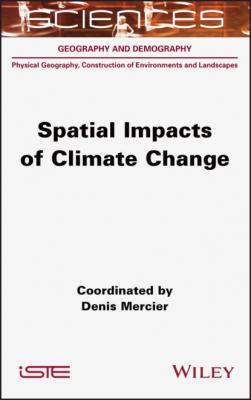Spatial Impacts of Climate Change. Denis Mercier
Читать онлайн.| Название | Spatial Impacts of Climate Change |
|---|---|
| Автор произведения | Denis Mercier |
| Жанр | География |
| Серия | |
| Издательство | География |
| Год выпуска | 0 |
| isbn | 9781119817901 |
At the regional scale, the spatial impacts of contemporary climate change are being addressed using a variety of approaches. By modifying the cryosphere in high latitudes and high mountains, changes in climate induce changes in the paraglacial sedimentary cascade (see Chapter 5) and periglacial environments (see Chapter 6). River organisms in cold environments (see Chapter 7) and temperate environments (see Chapter 8) record climate change in different ways. The melting glaciers of Central Asia place the consequences of climate change at the heart of geopolitical issues in this region (see Chapter 9).
At the local level, the impact of rainier season droughts in the western Mediterranean basin on Spanish rain-fed agriculture provides a link between regional climate dynamics and local impacts (see Chapter 10).
Multi-scalar approaches also make it possible to show the stakes of contemporary climate change on viticulture (see Chapter 11), on the scale of the Amazon basin (see Chapter 12), on the distribution of biomes (see Chapter 13) or on the distribution of birds (see Chapter 14).
In all the chapters, the examples analyzed underline the importance of geographical approaches for the study of the impacts of contemporary climate change.
I.3. References
Feng, J., Zhang, Y., Cheng, Q., San Liang, X., Jiang, T. (2019). Analysis of summer Antarctic sea ice anomalies associated with the spring Indian Ocean dipole. Global and Planetary Change, 181 [Online]. Available at: https://doi.org/10.1016/j.gloplacha.2019.102982.
Jones, M.W., Smith, A., Bettes, R., Canadell, J.G., Prentice, C., Le Quere, C. (2020). Climate change increases the risk of wildfires. ScienceBrief [Online]. Available at: https://sciencebrief.org/topics/climate-change-science/wildfires.
Kämpf, J. and Kavi, A. (2019). SST variability in the eastern intertopical Indian Ocean - On the search for trigger mechanisms of IOD events. Deep Sea Research Part II: Tropical Studies in Oceanography, 166, 64-74.
1
Climate Change at Different Temporal and Spatial Scales
Denis Mercier
Sorbonne University, Paris, France
1.1. Contemporary global climate change
Contemporary climate change refers to the period from 1850 to the present day and covers the period from the Industrial Revolution to the digital revolution. It also covers a period during which humanity experienced a population explosion, reaching 1 billion people for the first time in 1820. On January 1, 2020, the human population was estimated at 7.7 billion and is expected to reach 11 billion by 2100, according to the UN.
Through the use of fossil fuels (coal, oil, gas) and increased agricultural production to feed the world’s growing population, these elements contribute to increasing humanity’s role in the climate machine.
Since the mid-19th Century, the average global air temperature has increased by 1.1 °C. This increase has not been linear over time and Figure 1.1 illustrates the stages of this evolution. Two warming sequences help to understand this increase: the first from 1910 to 1940 and the second from 1980 to the present day, during which the increase in temperature was 0.18°C per decade. According to the World Spatial Impacts of Climate Change, coordinated by Denis Mercier. © ISTE Ltd 2021.
Meteorological Organization1, the year 2019 was the second warmest year recorded since 1850. It comes after the year 2016, which experienced a particularly intense El Niño episode, with abnormally high ocean surface water temperatures in the eastern South Pacific. These two periods of warming are interspersed by temporal sequences of cooling (from 1880 to 1910, then from 1940 to 1980).
Figure 1.1. Annual mean surface temperature from 1880 to 2019 compared to the 1880-1920 mean
(source: Sato and Hansen, Climate Science, Awareness and Solutions at Columbia University Earth Institute, 2020). For a color version of this figure, see www.iste.co.uk/mercier/climate.zip
This non-linear temperature evolution over time is not spatially homogeneous (see Figure 1.2). These maps illustrate general trends. Continental land areas record this contemporary global warming better than ocean surfaces; of these continental land surfaces, those with a hypercontinental climate such as Siberia are experiencing the greatest temperature increases.
Although the map projection is not very favorable, Figure 1.2 shows that high latitude regions, especially the Arctic basin and its surroundings, have experienced the greatest increases in temperature.
Figure 1.2. Average surface temperature per decade from 1910 to 2017 compared to the 1951-1980 average. For a color version of this figure, see www.iste.co.uk/mercier/climate.zip
(source: 2018 NASA-GISS temperature data, downloaded from https://data.giss.nasa.gov/gistemp/)
Although the oceans are warming less than land areas, they are still warming and store 93% of the excess heat. The last 10 years are the warmest recorded for ocean surface waters since 1955 with a linearly increasing temperature trend since the 1980s (see Figure 1.3) (Cheng et al. 2020). For the first period, the warming was relatively constant of approximately 2.1 ± 0.5 Zetta Joules2 per year. However, the warming in the more recent period is greater than that of the previous warming (9.4 ± 0.2 Zetta Joules per year, or 0.58 watt per m2 on average on the Earth's surface), hence the significant increase in the rate of global climate change at the ocean scale (Cheng et al. 2020).
Figure 1.3. Ocean heat content (OHC) in the upper water section above 2,000 m from 1955 to 2019. For a color version of this figure, see www.iste.co.uk/mercier/climate.zip
